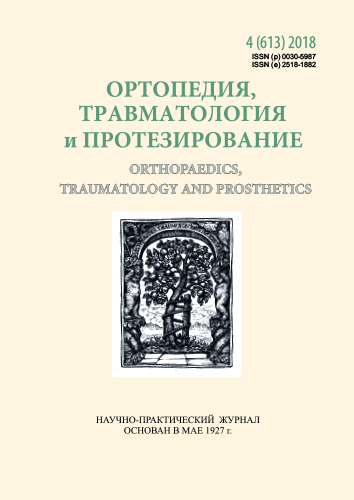The motor-muscle requirements for different methods of opponenoplasty (experimental study)
DOI:
https://doi.org/10.15674/0030-5987201845-13Keywords:
functional state of the muscle, opposition of the first finger, opponenplasty transposition, experimentAbstract
Objective: to determine in an experiment the ability of muscle-motors to provide the effectiveness of oponenoplasty techniques for which they are applied, including reducing of their power characteristics. Methods: simulation was carried out on 5 fresh cadavers hands and forearms. Comparative analysis of the 7 most prevalent methods of opponenoplasty was made. The techniques were differed by selecting of the muscle, block-suture and tendon insertion points to the different thumb structures. The tension for transposed tendons has carried out through an electronic dynamometer with recording of force, excursion, and amplitude of the thumb deviation. We calculated the necessary strength and the work of the transposed muscle to realize the effectiveness of the techniques in angular indices and in points by Kapandji. Results: physiological characteristics of the target muscle-motors (forces, amplitudes and work parameters) were enough for Steindler, Thompson, and Bunnell techniques effectiveness in all insertion variants. However, do not effective enough to the parameters of insufficient physiological excursion for Guber methods, and were not insufficient by force and work parameters for Edgerton-Brand, Burkhalter and Taylor methods. When the strength of the target muscleengine decreases to the M4 level, the effectiveness of the tested techniques significantly decreases: Thompson — up to 2 points by Kapandji, Steindler and Bunnell — up to 1–2, for others — tends to zero. Conclusions: in experimental study with physiological parameters and a functional state of the muscle-motor up to M5 — most of the opponenoplasty are effective, with a decrease in its strength to M4 — are ineffective. The obtained data allowed us to select the method of opponenoplasty according to the resources and functional state of the muscle-motor and to predict the effectiveness of treatment.
References
- Strafun, S. S., Oberemok, M. P., Lysak, A. S., & Tymoshenko, S. V. (2018). Orthopadic restoration of thumb opposition in consequences of the upper extremity trauma. Trauma, 19 (3), 5–11. doi: https://doi.org/10.22141/1608-1706.3.19.2018.136400. (Ukrainian)
- Bezugly, A., Oberechok, M. P., Tymoshenko, S. V.,& Lilyasch, A. S. (2018). Use of «wide awake» anesthesia to improve the results of tendon-muscle transpositions on the brush. Klinicheskaia Khirurgiia, 85 (4), 43–45. doi: https://doi.org/10.26779/2522 1396.2018.04.43 (Ukrainian)
- Wilbur, D., & Hammert, W. C. (2016). Principles of tendon transfer. Hand Clinics, 32 (3), 283–289. doi: https://doi.org/10.1016/j.hcl.2016.03.001
- Kapanji, A. I. (2009). Upper limb. Physiology of joints. Moskow: EKSMO.
- Kapandji A. I. (1992). Clinical evaluation of the thumb's opposition. Journal of Hand Therapy, 5 (2), 102–106. doi: https://doi.org/10.1016/S0894-1130(12)80265-1
- Tubiana, R. (1993). Paralyses of the thumb. Philadelphia: WB Saunders, 182–253.
- Ramselaar, J. M. (1970). Tendon transfers to restore opposition of the thumb. doi: https://doi.org/10.1007/978-94-011-6780-2
- Nikolayev, L. P. (1950) Manual on Biomechanics in Application to Traumatology, Orthopedics and Prosthetics.
- Medical Research Council (Great Britain), & University of Edinburgh. (1943). Aids to the investigation of peripheral nerve injuries.
- Paternostro-Sluga, T., Grim-Stieger, M., Posch, M., Schuhfried, O., Vacariu, G., Mittermaier, C., … Fialka-Moser, V. (2008). Reliability and validity of the Medical Research Council (MRC) scale and a modified scale for testing muscle strength in patients with radial palsy. Journal of Rehabilitation Medicine, 40 (8), 665–671. doi: https://doi.org/10.2340/16501977-0235
- Bunnell, S. (1956) Surgery of the hand. Philadelphia: Lippincott Co.
- Thompson, T. C. (1942). A modified operation for opponens paralysis. Journal of Bone and Joint Surgery. Am., 24, 632–640.
- Huber, E. (1921). Hilfsoperation bei Medianuslähmung. Deutsche Zeitschrift für Chirurgie, 162 (3–4), 271–275. doi: https://doi.org/10.1007/bf02801234
- Burkhalter, W., Christensen, R. C, Brown, P. (1973) Extensor indicis proprius opponensplasty. Journal of Bone and Joint Surgery. Am., 55 (4), 725–732.
- Edgerton, M. T., & Brand, P. W. (1965). Restoration of abduction and adduction to the unstable thumb in median and ulnar paralysis. Plastic and Reconstructive Surgery, 36 (2), 150–164. doi: https://doi.org/10.1097/00006534-196508000-00002
- Steindler, A. (1918). Orthopaedic operations on the hand. JAMA, 71, 1288–1236.
Downloads
How to Cite
Issue
Section
License
Copyright (c) 2019 Sergiy Strafun, Mykola Oberemok, Oleksiy Chkalov, Volodymyr Yurchenko, Sergiy Timoshenko

This work is licensed under a Creative Commons Attribution 4.0 International License.
The authors retain the right of authorship of their manuscript and pass the journal the right of the first publication of this article, which automatically become available from the date of publication under the terms of Creative Commons Attribution License, which allows others to freely distribute the published manuscript with mandatory linking to authors of the original research and the first publication of this one in this journal.
Authors have the right to enter into a separate supplemental agreement on the additional non-exclusive distribution of manuscript in the form in which it was published by the journal (i.e. to put work in electronic storage of an institution or publish as a part of the book) while maintaining the reference to the first publication of the manuscript in this journal.
The editorial policy of the journal allows authors and encourages manuscript accommodation online (i.e. in storage of an institution or on the personal websites) as before submission of the manuscript to the editorial office, and during its editorial processing because it contributes to productive scientific discussion and positively affects the efficiency and dynamics of the published manuscript citation (see The Effect of Open Access).














